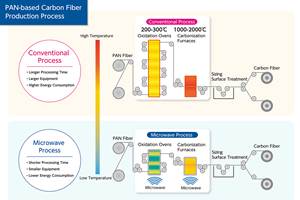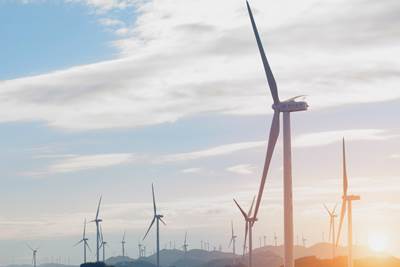U.S. DOE releases comprehensive strategy to secure the U.S. clean energy sector
DOE report includes more than 60 actions to enhance supply chain resiliency — referencing composites and wind recycling — spur domestic manufacturing capacity and create U.S. jobs.

Photo Credit: U.S. DOE
On Feb. 24, the U.S. Department of Energy (DOE, Washington, D.C., U.S.) released a comprehensive plan to ensure security and increase the United States’ energy independence. The report, “America’s Strategy to Secure the Supply Chain for a Robust Clean Energy Transition,” lays out dozens of critical strategies to build a secure, resilient and diverse domestic energy sector industrial base that will establish the United States’ role as a global leader in clean energy manufacturing and innovation. It is accompanied by 13 several issue-specific deep-dive assessments across the energy sector —ranging from solar energy to semiconductors to cybersecurity — in response to the current administration’s Executive Order 14017, America’s Supply Chains.
Within this deep dive, amongst other topics, the report also examines the following U.S. wind industry supply chain segments: components, sub-components, processed materials, raw materials, wind industry recycling, digital products and workforce, for both land-based and offshore wind. Composite materials use and wind blade recycling are identified (see Fig. 5 schematic, p. 16 of full report), and domestic developments that need to be considered in these areas.
As the Federal government begins to implement the Bipartisan Infrastructure Law, which provides $62 billion in energy sector funding, DOE’s report summarizes how the U.S. can capture the economic opportunity inherent in the energy sector transition and build a world-class U.S. energy manufacturing base and workforce.
“Taking bold action to invest in our supply chains means America will reap the tremendous opportunities that tackling climate change presents to kickstart domestic manufacturing and help secure our national, economic, and energy security,” says U.S. Secretary of Energy Jennifer M. Granholm. “The strength of a nation relies on resilient and reliable critical supply chains across sectors, and DOE’s report provides the key strategies and recommendations for Congress and the dederal government to act now to help deliver more jobs and a stronger, cleaner future.”
Demand for clean energy technologies such as wind turbines and batteries for electric vehicles (EVs) has increased significantly as technology costs have plummeted over the last decade. The global clean energy market is expected to grow exponentially — reaching $23 trillion at a minimum by 2030.
Without new domestic raw materials production and manufacturing capacity, the U.S. will continue to rely on clean energy imports, exposing the nation to supply chain vulnerabilities while simultaneously losing out on the job opportunities associated with the energy transition. Yet, in many cases, the DOE says the U.S. has untapped potential to support greater domestic production.
Recent shortages of foreign-manufactured automotive semiconductor chips due to the COVID-19 pandemic have forced slowdowns at U.S. car manufacturing plants, highlighting how shortages can hurt U.S. workers. The strategies and actions included in this report will reportedly ensure the U.S. has the capacity to respond quickly in the face of challenges such as global production shortages, trade disruptions and natural disasters, as well as bolster a domestic clean energy supply chain that leads the global economy.
“America’s Strategy to Secure the Supply Chain for a Robust Clean Energy Transition” provides seven key areas for boosting supply chain resiliency and rebuilding U.S. manufacturing:
- Increase availability of critical materials: Critical minerals, such as cobalt for batteries and rare earth elements like neodymium for offshore wind, are key components to the clean energy technology required to achieve national climate and economic goals.
- Expand domestic manufacturing capabilities: There is opportunity to boost the United States’ manufacturing capabilities Through efforts such as increased funding for workforce development, investments in manufacturing programs to support the clean energy transition and coordinating with manufacturers and state, local, and tribal governments to support the establishment of regional clean energy industrial clusters.
- Invest and support the formation of diverse, reliable and socially responsible foreign supply chains: This will complement domestic opportunities to diversify clean energy supply chains, such as promoting the adoption and implementation of traceability standards to improve global supply chain mapping capabilities. These actions will instill integrity of product custody, and support carbon footprinting of energy supply chains, as well as build on current efforts to support investments in the United States’ supply chain security — such as investing in a graphite mine in Mozambique — a mineral key to lithium-ion battery manufacturing.
- Increase the adoption and deployment of clean energy: By leveraging federal purchasing power, the U.S. can provide a sustained demand signal for both domestic clean energy products and the capability to manufacture them domestically, advancing activities to grow and sustain the demand signal for sustainable transportation fuels and associated supply chain industries.
- Improve end-of-life (EOL) energy-related waste management: This includes advancing technologies to recycle and recover valuable materials like batteries, aluminum and steel that can continue to feed domestic clean energy supply chains safely and effectively.
- Attract and support a skilled workforce for the clean energy transition: By working across government to embed strong labor standards and support for organized labor in federal funding for the energy sector industrial base, and engaging key stakeholders, the U.S. can set strategic nationwide plans to encourage the creation of good, family-sustaining, union jobs with competitive wages and benefits.
- Enhance supply chain knowledge and decision-making: Developing supporting studies that assess and quantify the economic, environmental, social and human rights impacts of different aspects of the energy supply chain for all clean technologies, and the creation and maintenance of a manufacturing and energy supply chain office as well as database and analytical modeling capabilities, will help ensure supply chain policy and investment decisions are grounded in an understanding of critical factors such as risks, dependencies, material availability and supply chain and market dynamics.
DOE reports that it has already made progress addressing supply chain vulnerabilities and is taking significant steps to further secure the United States’ energy supply chains. Ongoing efforts include:
- Mining Innovations for Negative Emissions Resources (MINER) Program: DOE released a $44 million funding opportunity for the MINER program which will provide commercial-ready technologies that give the U.S. a net-zero or net-negative emissions pathway toward increased domestic supplies of copper, nickel, lithium, cobalt, rare earth elements and other critical elements required for a clean energy transition.
- New Manufacturing and Energy Supply Chains Office: DOE is creating a new Manufacturing and Energy Supply Chains Office that will focus on strengthening and securing energy supply chains needed to modernize the nation’s energy infrastructure and support the clean energy transition. This office will engage with private-sector companies, other federal agencies and key stakeholders to collect, analyze, respond to and share data about energy supply chains to inform future decision-making and investment.
- Rare Earth Element Facility: DOE has released a Request for Information for the $140 million allocated from the Bipartisan Infrastructure Law for the design, construction and build-out of a facility to demonstrate the commercial feasibility of a full-scale integrated rare earth element facility for extraction, separation and refining. This facility will accelerate U.S.-made rare earth elements processing technologies that will boost domestic manufacturing of rare earth metals crucial for clean energy and national defense industries.
- Clean Hydrogen Hubs: DOE has released a Request for Information for the $8 billion allocated from the Bipartisan Infrastructure Law to establish at least four Regional Clean Hydrogen Hubs to serve as a network of clean hydrogen producers, potential clean hydrogen consumers and connective infrastructure.
- High-Capacity Batteries: Building on the 100-day supply chain report on high-capacity batteries issued by DOE last spring, Congress included in the Bipartisan Infrastructure Law more than $6 billion to fund domestic battery materials processing, manufacturing and recycling that will help improve grid resilience and scale up the electrification of cars, trucks and buses. These grants, starting with two Notices of Intent just released for funding worth nearly $3 billion, will allow companies to expand and build new U.S. factories with quality job opportunities in regions throughout the country.
Critical Minerals and the National Defense Stockpile: The Departments of Energy, Defense and State executed a memorandum of agreement (MOA) that sets the foundation for a critical minerals stockpile to support the U.S. transition to clean energy and national security needs. The MOA formalizes an interagency partnership to acquire and recycle selected materials for technologies that range from grid-scale batteries to wind turbines.
To learn more about this comprehensive report, view the Fact Sheet or visit www.energy.gov/policy/supplychains to download the entire report.
Related Content
JEC World 2023 highlights: Recyclable resins, renewable energy solutions, award-winning automotive
CW technical editor Hannah Mason recaps some of the technology on display at JEC World, including natural, bio-based or recyclable materials solutions, innovative automotive and renewable energy components and more.
Read MoreMicrowave heating for more sustainable carbon fiber
Skeptics say it won’t work — Osaka-based Microwave Chemical Co. says it already has — and continues to advance its simulation-based technology to slash energy use and emissions in manufacturing.
Read MoreComposites end markets: Electronics (2024)
Increasingly, prototype and production-ready smart devices featuring thermoplastic composite cases and other components provide lightweight, optimized sustainable alternatives to metal.
Read MoreBio-based acrylonitrile for carbon fiber manufacture
The quest for a sustainable source of acrylonitrile for carbon fiber manufacture has made the leap from the lab to the market.
Read MoreRead Next
Spirit Aerosystems converts to 100% renewable wind energy in Kansas headquarters
Leading Tier 1 Supplier of composites increases global renewable power usage to 75% toward 30% reduction in its greenhouse gas emissions by 2030.
Read MoreSecond U.S. offshore wind project gains approval to begin construction
Developers have establishd a domestic supply chain for critical components to make the 132-MW project located off of Long Island, New York a reality.
Read MoreAll-recycled, needle-punched nonwoven CFRP slashes carbon footprint of Formula 2 seat
Dallara and Tenowo collaborate to produce a race-ready Formula 2 seat using recycled carbon fiber, reducing CO2 emissions by 97.5% compared to virgin materials.
Read More
























